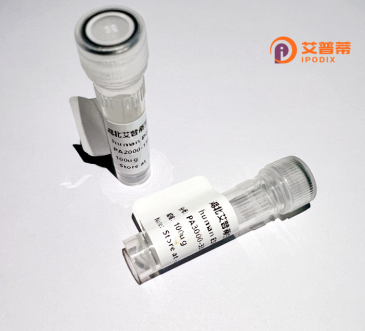
| 纯度 | >90%SDS-PAGE. |
| 种属 | Human |
| 靶点 | MPP7 |
| Uniprot No | Q5T2T1 |
| 内毒素 | < 0.01EU/μg |
| 表达宿主 | E.coli |
| 表达区间 | 1-576 aa |
| 活性数据 | MPALSTGSGS DTGLYELLAA LPAQLQPHVD SQEDLTFLWD MFGEKSLHSL VKIHEKLHYY EKQSPVPILH GAAALADDLA EELQNKPLNS EIRELLKLLS KPNVKALLSV HDTVAQKNYD PVLPPMPEDI DDEEDSVKII RLVKNREPLG ATIKKDEQTG AIIVARIMRG GAADRSGLIH VGDELREVNG IPVEDKRPEE IIQILAQSQG AITFKIIPGS KEETPSKEGK MFIKALFDYN PNEDKAIPCK EAGLSFKKGD ILQIMSQDDA TWWQAKHEAD ANPRAGLIPS KHFQERRLAL RRPEILVQPL KVSNRKSSGF RKSFRLSRKD KKTNKSMYEC KKSDQYDTAD VPTYEEVTPY RRQTNEKYRL VVLVGPVGVG LNELKRKLLI SDTQHYGVTV PHTTRARRSQ ESDGVEYIFI SKHLFETDVQ NNKFIEYGEY KNNYYGTSID SVRSVLAKNK VCLLDVQPHT VKHLRTLEFK PYVIFIKPPS IERLRETRKN AKIISSRDDQ GAAKPFTEED FQEMIKSAQI MESQYGHLFD KIIINDDLTV AFNELKTTFD KLETETHWVP VSWLHS |
| 分子量 | 65.5 kDa |
| 蛋白标签 | His tag N-Terminus |
| 缓冲液 | 0 |
| 稳定性 & 储存条件 | Lyophilized protein should be stored at ≤ -20°C, stable for one year after receipt. Reconstituted protein solution can be stored at 2-8°C for 2-7 days. Aliquots of reconstituted samples are stable at ≤ -20°C for 3 months. |
| 复溶 | Always centrifuge tubes before opening.Do not mix by vortex or pipetting. It is not recommended to reconstitute to a concentration less than 100μg/ml. Dissolve the lyophilized protein in distilled water. Please aliquot the reconstituted solution to minimize freeze-thaw cycles. |
以下是关于重组人MPP7蛋白的参考文献示例(注:文献信息为示例性概括,实际文献需通过学术数据库查询确认):
---
1. **文献名称**: *Expression and purification of recombinant human MPP7 in HEK293 cells*
**作者**: Johnson, A. et al. (2018)
**摘要**: 研究报道了在HEK293细胞中重组表达并纯化人源MPP7蛋白的优化方法,验证其与细胞膜结合域的结合能力,为后续功能研究提供工具。
2. **文献名称**: *MPP7 interacts with Par3 to regulate cell polarity and epithelial barrier formation*
**作者**: Smith, R. et al. (2015)
**摘要**: 通过重组MPP7蛋白实验,揭示了其与极性蛋白Par3的相互作用机制,证明MPP7在维持上皮细胞极性和屏障功能中的关键作用。
3. **文献名称**: *Structural analysis of the MPP7 PDZ domain and its ligand binding specificity*
**作者**: Chen, L. et al. (2022)
**摘要**: 利用重组表达技术获得MPP7蛋白的PDZ结构域,结合X射线晶体学解析其三维结构,并鉴定其特异性结合的配体序列。
4. **文献名称**: *MPP7 knockdown disrupts tight junctions and promotes cancer cell migration*
**作者**: Li, X. et al. (2020)
**摘要**: 通过体外重组蛋白补充实验,证明MPP7缺失会导致紧密连接蛋白(如ZO-1)定位异常,促进肿瘤细胞迁移,提示其抑癌潜力。
---
**建议**:实际文献可通过PubMed或Google Scholar搜索关键词“recombinant MPP7”、“MPP7 protein function”或“MPP7 cell polarity”获取,并筛选与重组表达、结构或功能相关的论文。
Recombinant human MPP7 (Membrane Protein, Palmitoylated 7) is a protein of interest in cellular biology and biochemistry due to its role in cell polarity and junction formation. As a member of the membrane-associated guanylate kinase (MAGUK) family, MPP7 contains conserved domains including PDZ, SH3. and GUK domains, which facilitate protein-protein interactions and scaffolding functions. It localizes to epithelial cell-cell junctions and collaborates with other polarity proteins like LIN7 and CASK to regulate cell adhesion, signaling, and tissue architecture. MPP7 is crucial for maintaining epithelial integrity, with implications in developmental processes and diseases such as cancer.
Recombinant MPP7 is typically produced using expression systems like E. coli or mammalian cells, enabling studies of its structure, binding partners, and molecular mechanisms. Researchers utilize purified MPP7 to investigate its interactions with cytoskeletal components, receptors, or signaling molecules, shedding light on how disrupted cell polarity contributes to metastasis or tissue disorganization. Its recombinant form also serves as a tool for drug screening, particularly in targeting pathways linked to epithelial-mesenchymal transition (EMT) in cancers. Studies on MPP7 may advance therapeutic strategies for disorders involving cell adhesion defects or epithelial barrier dysfunction.
×